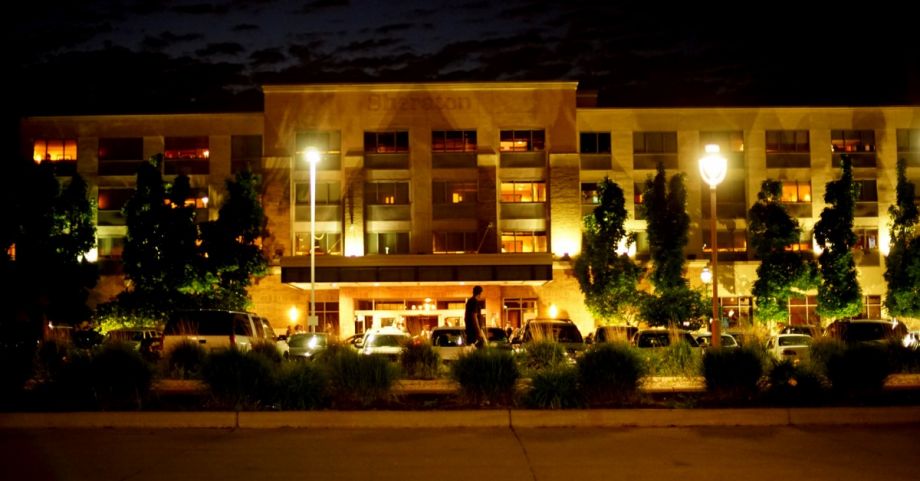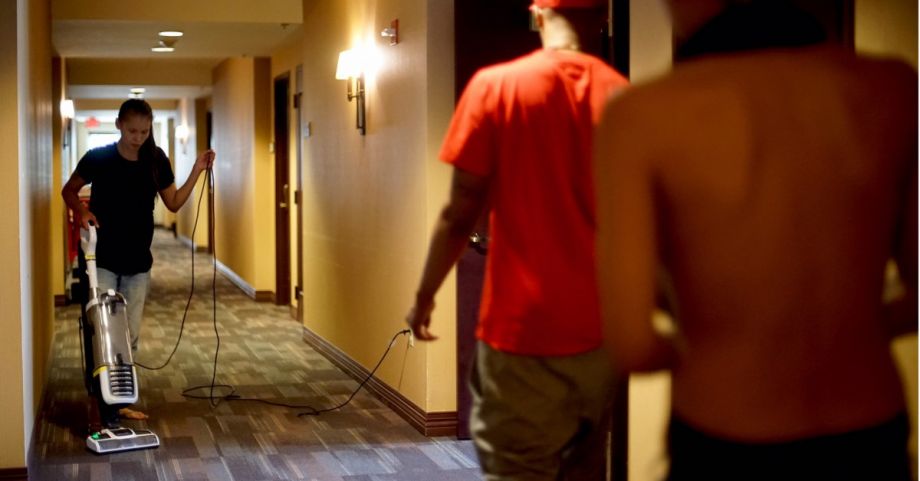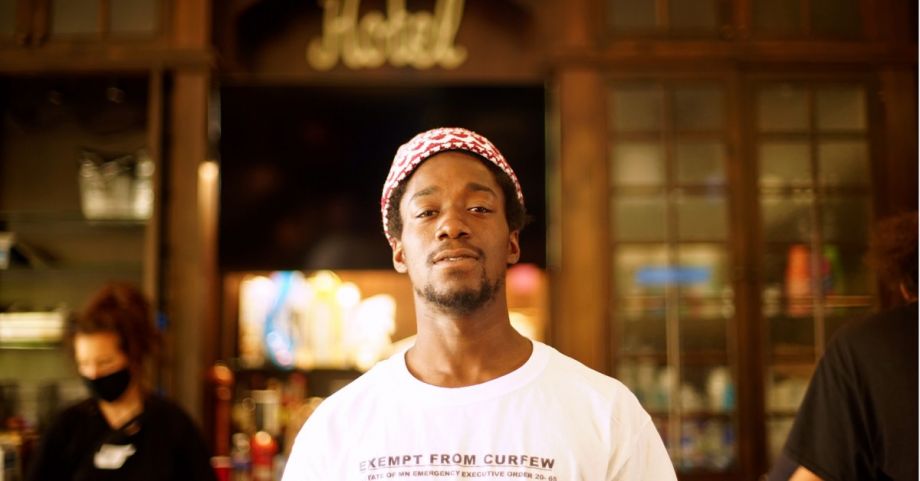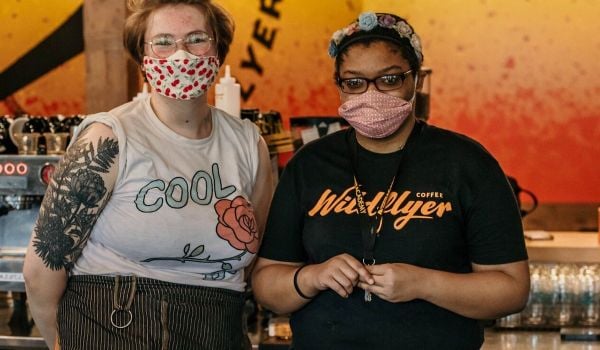On the Friday night after George Floyd was killed by police, as conflicts were flaring between protestors and police in Minneapolis, a group of advocates took it on themselves to book a room in a Sheraton Hotel for a homeless couple that had nowhere else to go. The next day, according to one of the advocates, the hotel’s owner said that he had to evacuate the remaining guests because of the unrest and concerns about his insurance policy.
But by then the volunteers needed housing for more families that had been displaced from nearby encampments, and they negotiated to buy a block of 20 rooms in the Sheraton. By the third night, they had filled all 136 rooms in the hotel, and they were keeping a growing waitlist. A group of volunteers began working shifts cleaning, serving food, providing security, printing key cards, and everything else needed to operate the hotel. They began referring to it as the Sanctuary Hotel, or the Share-a-Ton. At its peak, during the second week of June, 150 volunteers staffed the hotel over the course of 24 hours.
It was a stunning experiment in direct support for people experiencing homelessness, something no one had even imagined just a few days prior. And, says Rachel Bean, who normally works in a “wet house” facility in Minneapolis, where alcoholics are provided housing and permitted to drink, it was the first time that advocates had been able to cut through the official bureaucracy and do what needed to be done in the moment. There were tensions, and concerns about residents’ safety in the hotel. But violence, trauma, and the threat of spreading COVID-19 were already realities of living on the street, says Bean.
“There was always this hovering feeling,” she says, “that it was beautiful, and that it could be a disaster at the same time. The real feeling of risk, of unsafety, was happening in the street because of the military response and civil unrest. That was the initial priority — to get people inside.”

(Photo courtesy Sanctuary Hotel)
In the Twin Cities region, like in most other big metropolitan areas, homelessness is managed by a network of government offices, nonprofit organizations, police forces, neighborhood volunteers, and families and friends of unhoused people. And just as it is in most other metros, that network is inadequate. Minnesota counted more than 10,000 people experiencing homelessness last year, its highest count since the early 1990s. Around 4,000 of those people were in Hennepin County, which is home to Minneapolis. Nearly 800 were living on the street in Hennepin County. When COVID-19 began spreading in the U.S., homelessness transformed from one aspect of the slow-rolling housing crisis to an urgent public-health emergency.
In March, as city, county, and state officials began mobilizing efforts to prevent the spread of COVID-19 in homeless communities, a loose coalition of advocates started providing supplementary resources on their own. That included everything from food, water, and sanitation supplies to legal help for people living in encampments, says Bean. The need for basic services among the homeless population was stark, Bean says, and it wasn’t being matched by the government’s response.
And then, she says, “This moment happened where George Floyd was murdered, and suddenly we have this highly militarized occupation in the city, and people experiencing homelessness are technically exempt from curfews but they’re being indiscriminately targeted by the police along with everyone else.”
From that chaos emerged the Sanctuary Hotel. The owner, Jay Patel, was initially cooperative, and never ended up accepting any of the money that the volunteers had agreed to pay on the first few nights, Bean says. (Patel did not respond to multiple requests for an interview.) But the organizers — who were not being paid, or organized professionally, and instead just happened to know each other from housing advocacy work prior to the uprising — fairly quickly realized that running a fully-occupied hotel for otherwise unhoused people during a pandemic and civil unrest required “an unsustainable amount of coordination and staffing,” Bean says.
“The reality is that we do not have the capacity to sustainably staff the project of this scale with just volunteers,” Bean said last week, as families were starting to vacate the hotel. “And we feel like we’ve demonstrated the need for an entity that has more resources … to take over.”

Rosemary Fister, a Minneapolis community organizer says, “George Floyd was a shelter worker. He worked at the largest homeless shelter in Minneapolis. He supported and advocated for people experiencing homelessness while he was alive, and this will be a part of his legacy.” (Photo courtesy Sanctuary Hotel)
At the same time that the volunteers in Minneapolis were setting up the Sanctuary Hotel, the official apparatus for homeless services in Minnesota was finding shelter for people displaced from encampments as well. There were several encampments near the center of the uprisings, says Cathy ten Broeke, assistant commissioner for Minnesota Housing and the executive director of the Interagency Council on Homelessness, the state’s coordinated homelessness response effort. Working with local housing providers, Minnesota Housing was able to find hotel rooms for 40 people from one camp and 72 people from another camp during the same weekend that the Sanctuary Hotel was being set up. They were parallel efforts in response to the same emergency, ten Broeke says.
“At first, we had so little information [about the Sanctuary Hotel],” ten Broeke says. “I remember asking, who’s the service provider? Who’s in charge? Who’s doing it? And it was nobody … The spirit of that was really impressive and an incredible grassroots effort.”
“Then, of course, we got enormously worried about all of those folks and what was going to happen next,” she says.
At the height of the Sanctuary Hotel’s occupancy, volunteers had hundreds of people on a waiting list, and were looking for additional properties to house people, Bean says. And they were also hoping that a nonprofit or government agency with real resources would take over the project. But ten Broeke says it wasn’t a sustainable project — in order to last, it would need site control, funding, and a plan in place to transition residents to permanent housing. But like so much else that happened in Minneapolis in early June, it was a spontaneous outpouring of aid by a community in crisis.
“I think this is a moment to seize, and we keep talking about how the crisis response, both to COVID and the civil unrest, has centered homelessness as the emergency public health issue that it is,” ten Broeke says. “We also know that urgent action requires partnership and collaboration and support and resources and connection. It’s not enough to be urgent.”
Overall, Minnesota Housing and its partners moved 190 people from encampments into hotels during the uprising, ten Broeke says. Service providers are working with those individuals to try to find housing for them, ten Broeke says.
By June 9, the residents of the Sanctuary Hotel were facing eviction, and they began moving out that week. The organizers, volunteers, and residents held a press conference that day, where residents talked about the dangers they were facing living on the street prior to finding a room in the hotel. (Mother Jones has a thorough report on the Sanctuary Hotel’s brief life by a journalist who was on the scene.)
After leaving the Sheraton, some residents began reestablishing encampments in nearby Peavey and Powderhorn parks, according to organizers. Soon after, the Minneapolis Parks and Recreation Board voted to commit “sanctuary” space in the city’s parks for people experiencing homelessness. Just a few days before, the Minneapolis City Council had voted to disband and rebuild the Minneapolis Police Department — one response to the widespread demand to defund the police that has taken hold in the wake of George Floyd’s murder. For the organizers of the Sanctuary Hotel, the project was one vision of an alternate future, among many that sprang up during several chaotic weeks in Minneapolis.
“It was very hard work, and it was a constant negotiation, but a lot of it was about how to do this work outside of the policing framework,” Bean says. “What does it mean to build community safety in a totally community-driven way? What does it mean to support people with trauma and mental illness and substance-abuse issues? Safe for whom? Safe from whom? All of those questions were being asked in real time.”
This article is part of Backyard, a newsletter exploring scalable solutions to make housing fairer, more affordable and more environmentally sustainable. Subscribe to our weekly Backyard newsletter.

Jared Brey is Next City's housing correspondent, based in Philadelphia. He is a former staff writer at Philadelphia magazine and PlanPhilly, and his work has appeared in Columbia Journalism Review, Landscape Architecture Magazine, U.S. News & World Report, Philadelphia Weekly, and other publications.
Follow Jared .(JavaScript must be enabled to view this email address)


















